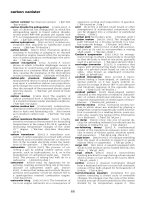Engineering Mechanics - Statics Episode 1 Part 5 ppt
Bạn đang xem bản rút gọn của tài liệu. Xem và tải ngay bản đầy đủ của tài liệu tại đây (680.34 KB, 40 trang )
Engineering Mechanics - Statics Chapter 3
b 2ft=
Guesses
δ
1ft=
φ
10 deg=
T 1lb= F 1lb=
x 1ft=
Given
T− cos
θ
()
F cos
φ
()
+ 0=
Tsin
θ
()
F sin
φ
()
+ P− 0=
Fkx
δ
−
()
=
asin
θ
()
xsin
φ
()
=
acos
θ
()
xcos
φ
()
+ ab+=
δ
φ
T
F
x
⎛
⎜
⎜
⎜
⎜
⎜
⎝
⎞
⎟
⎟
⎟
⎟
⎟
⎠
Find
δφ
, T, F, x,
()
=
T
F
⎛
⎜
⎝
⎞
⎟
⎠
69.28
40.00
⎛
⎜
⎝
⎞
⎟
⎠
lb=
δ
2.66 ft=
Problem 3-33
The flowerpot of mass M is
suspended from three wires and
supported by the hooks at B and C.
Determine the tension in AB and AC
for equilibrium.
Given:
M 20 kg=
l
1
3.5 m=
l
2
2m=
l
3
4m=
161
© 2007 R. C. Hibbeler. Published by Pearson Education, Inc., Upper Saddle River, NJ. All rights reserved.
This material is protected under all copyright laws as they currently exist. No portion of this material may
be reproduced, in any form or by any means, without permission in writing from the publisher.
Engineering Mechanics - Statics Chapter 3
l
4
0.5 m=
g 9.81
m
s
2
=
Solution:
Initial guesses:
T
AB
1N= T
AC
1N=
θ
10 deg=
φ
10 deg=
Given
T
AC
− cos
φ
()
T
AB
cos
θ
()
+ 0=
T
AC
sin
φ
()
T
AB
sin
θ
()
+ Mg− 0=
l
1
cos
φ
()
l
2
cos
θ
()
+ l
3
=
l
1
sin
φ
()
l
2
sin
θ
()
l
4
+=
T
AB
T
AC
θ
φ
⎛
⎜
⎜
⎜
⎜
⎝
⎞
⎟
⎟
⎟
⎟
⎠
Find T
AB
T
AC
,
θ
,
φ
,
()
=
θ
φ
⎛
⎜
⎝
⎞
⎟
⎠
53.13
36.87
⎛
⎜
⎝
⎞
⎟
⎠
deg=
T
AB
T
AC
⎛
⎜
⎝
⎞
⎟
⎠
156.96
117.72
⎛
⎜
⎝
⎞
⎟
⎠
N=
Problem 3-3
4
A car is to be towed using the rope arrangement shown. The towing force required is P. Determine
the minimum length l of rope AB so that the tension in either rope AB or AC does not exceed T.
Hint: Use the equilibrium condition at point A to determine the required angle
θ
for attachment, then
determine l using trigonometry applied to triangle ABC.
Given:
P 600 lb=
T 750 lb=
φ
30 deg=
162
© 2007 R. C. Hibbeler. Published by Pearson Education, Inc., Upper Saddle River, NJ. All rights reserved.
This material is protected under all copyright laws as they currently exist. No portion of this material may
be reproduced, in any form or by any means, without permission in writing from the publisher.
Engineering Mechanics - Statics Chapter 3
d 4ft=
Solution:
The initial guesses
T
AB
T=
T
AC
T=
θ
30 deg=
l 2ft=
Case 1: Assume
T
AC
T=
Given
+
→
Σ
F
x
= 0;
T
AC
cos
φ
()
T
AB
cos
θ
()
− 0=
+
↑
PT
AC
sin
φ
()
− T
AB
sin
θ
()
− 0=
Σ
F
y
= 0;
l
sin
φ
()
d
sin 180deg
θ
−
φ
−
()
=
T
AB
θ
l
1
⎛
⎜
⎜
⎜
⎝
⎞
⎟
⎟
⎟
⎠
Find T
AB
θ
, l,
()
= T
AB
687.39 lb=
θ
19.11 deg= l
1
2.65 ft=
Case 2: Assume
T
AB
T=
Given
+
→
Σ
F
x
= 0;
T
AC
cos
φ
()
T
AB
cos
θ
()
− 0=
+
↑
PT
AC
sin
φ
()
− T
AB
sin
θ
()
− 0=
Σ
F
y
= 0;
l
sin
φ
()
d
sin 180deg
θ
−
φ
−
()
=
T
AC
θ
l
2
⎛
⎜
⎜
⎜
⎝
⎞
⎟
⎟
⎟
⎠
Find T
AC
θ
, l,
()
= T
AC
840.83 lb=
θ
13.85 deg= l
2
2.89 ft=
l min l
1
l
2
,
()
= l 2.65ft=
163
© 2007 R. C. Hibbeler. Published by Pearson Education, Inc., Upper Saddle River, NJ. All rights reserved.
This material is protected under all copyright laws as they currently exist. No portion of this material may
be reproduced, in any form or by any means, without permission in writing from the publisher.
Engineering Mechanics - Statics Chapter 3
Problem 3-35
Determine the mass of each of the two cylinders if they cause a sag of distance d when suspended
from the rings at A and B. Note that s = 0 when the cylinders are removed.
Given:
d 0.5 m=
l
1
1.5 m=
l
2
2m=
l
3
1m=
k 100
N
m
=
g 9.81
m
s
2
=
Solution:
T
AC
kl
1
d+
()
2
l
2
2
+ l
1
2
l
2
2
+−
⎡
⎣
⎤
⎦
=
T
AC
32.84 N=
θ
atan
l
1
d+
l
2
⎛
⎜
⎝
⎞
⎟
⎠
=
θ
45deg=
M
T
AC
sin
θ
()
g
=
M 2.37 kg=
164
© 2007 R. C. Hibbeler. Published by Pearson Education, Inc., Upper Saddle River, NJ. All rights reserved.
This material is protected under all copyright laws as they currently exist. No portion of this material may
be reproduced, in any form or by any means, without permission in writing from the publisher.
Engineering Mechanics - Statics Chapter 3
The sling BAC is used to lift the load W with constant velocity. Determine the force in the sling
and plot its value T (ordinate) as a function of its orientation
θ
, where
0 θ≤ 90°≤
.
Solution:
W 2Tcos
θ
()
− 0=
T
1
2
W
cos
θ
()
⎛
⎜
⎝
⎞
⎟
⎠
=
Problem 3-37
The lamp fixture has weight W and is suspended from two springs, each having unstretched length L
and stiffness k. Determine the angle
θ
for equilibrium.
Units Used:
kN 10
3
N=
Given:
W 10 lb=
L 4ft=
k 5
lb
ft
=
a 4ft=
165
Problem 3-36
© 2007 R. C. Hibbeler. Published by Pearson Education, Inc., Upper Saddle River, NJ. All rights reserved.
This material is protected under all copyright laws as they currently exist. No portion of this material may
be reproduced, in any form or by any means, without permission in writing from the publisher.
Engineering Mechanics - Statics Chapter 3
The initial guesses:
T 200 lb=
θ
10 deg=
Given
Spring Tk
a
cos
θ
()
L−
⎛
⎜
⎝
⎞
⎟
⎠
=
+
↑
Σ
F
y
= 0;
2Tsin
θ
()
W− 0=
T
θ
⎛
⎜
⎝
⎞
⎟
⎠
Find T
θ
,
()
= T 7.34lb=
θ
42.97 deg=
Problem 3-38
The uniform tank of weight W is suspended by means of a cable, of length l, which is attached
to the sides of the tank and passes over the small pulley located at O. If the cable can be
attached at either points A and B, or C and D, determine which attachment produces the least
amount of tension in the cable.What is this tension?
Given:
W 200 lb=
l 6ft=
a 1ft=
b 2ft=
cb=
d 2a=
Solution:
Free Body Diagram:
By
observation, the force
F
has to
support the entire weight of the
tank. Thus, F = W. The tension in
166
Solution:
© 2007 R. C. Hibbeler. Published by Pearson Education, Inc., Upper Saddle River, NJ. All rights reserved.
This material is protected under all copyright laws as they currently exist. No portion of this material may
be reproduced, in any form or by any means, without permission in writing from the publisher.
Engineering Mechanics - Statics Chapter 3
cable is the same throughout the
cable.
Equations of Equilibrium
Σ
F
y
= 0;
W 2Tsin
θ
()
− 0=
Attached to CD
θ
1
acos
2 a
l
⎛
⎜
⎝
⎞
⎟
⎠
=
θ
1
70.53 deg=
Attached to AB
θ
2
acos
2 b
l
⎛
⎜
⎝
⎞
⎟
⎠
=
θ
2
48.19 deg=
We choose the largest angle (which will produce the smallest force)
θ
max
θ
1
θ
2
,
()
=
θ
70.53 deg=
T
1
2
W
sin
θ
()
⎛
⎜
⎝
⎞
⎟
⎠
= T 106lb=
Problem 3-39
A sphere of mass m
s
rests on the smooth parabolic surface. Determine the normal force it exerts
on the surface and the mass m
B
of block B needed to hold it in the equilibrium position shown.
Given:
m
s
4kg=
a 0.4 m=
b 0.4 m=
θ
60 deg=
g 9.81
m
s
2
=
Solution:
k
a
b
2
=
Geometry: The angle
θ
1
which the surface make with the horizontal is to be determined first.
167
© 2007 R. C. Hibbeler. Published by Pearson Education, Inc., Upper Saddle River, NJ. All rights reserved.
This material is protected under all copyright laws as they currently exist. No portion of this material may
be reproduced, in any form or by any means, without permission in writing from the publisher.
Engineering Mechanics - Statics Chapter 3
tan
θ
1
()
dy
dx
= 2 kx=
evaluated at
xa=
θ
1
atan 2 ka()=
θ
1
63.43 deg=
Free Body Diagram :
The tension in the cord is the same throughout the cord and is equal
to the weight of block B, m
B
g.
The initial guesses:
m
B
200 kg= F
N
200 N=
Given
+
→
Σ
F
x
= 0;
m
B
gcos
θ
()
F
N
sin
θ
1
()
− 0=
+
↑
Σ
F
y
= 0;
m
B
gsin
θ
()
F
N
cos
θ
1
()
+ m
s
g− 0=
m
B
F
N
⎛
⎜
⎝
⎞
⎟
⎠
Find m
B
F
N
,
()
= F
N
19.66 N=
m
B
3.58 kg=
Problem 3-40
The pipe of mass M is supported at A by a system of five cords. Determine the force in each
cord for equilibrium.
Given:
M 30 kg= c 3=
d 4=
g 9.81
m
s
2
=
θ
60 deg=
Solution:
Initial guesses:
T
AB
1N= T
AE
1N=
T
BC
1N= T
BD
1N=
Given
T
AB
sin
θ
()
Mg− 0=
T
AE
T
AB
cos
θ
()
− 0=
168
© 2007 R. C. Hibbeler. Published by Pearson Education, Inc., Upper Saddle River, NJ. All rights reserved.
This material is protected under all copyright laws as they currently exist. No portion of this material may
be reproduced, in any form or by any means, without permission in writing from the publisher.
Engineering Mechanics - Statics Chapter 3
T
BD
c
c
2
d
2
+
⎛
⎜
⎝
⎞
⎟
⎠
T
AB
sin
θ
()
− 0=
T
BD
d
c
2
d
2
+
⎛
⎜
⎝
⎞
⎟
⎠
T
AB
cos
θ
()
+ T
BC
− 0=
T
AB
T
AE
T
BC
T
BD
⎛
⎜
⎜
⎜
⎜
⎝
⎞
⎟
⎟
⎟
⎟
⎠
Find T
AB
T
AE
, T
BC
, T
BD
,
()
=
T
AB
T
AE
T
BC
T
BD
⎛
⎜
⎜
⎜
⎜
⎝
⎞
⎟
⎟
⎟
⎟
⎠
339.8
169.9
562.3
490.5
⎛
⎜
⎜
⎜
⎜
⎝
⎞
⎟
⎟
⎟
⎟
⎠
N=
Problem 3-41
The joint of a space frame is subjected to four forces. Strut OA lies in the x-y plane and strut OB lies
in the y-z plane. Determine the forces acting in each of the three struts required for equilibrium.
Units Used:
kN 10
3
N=
Given:
F 2kN=
θ
1
45 deg=
θ
2
40 deg=
Solution:
Σ
F
x
= 0;
R− sin
θ
1
()
0=
R 0=
169
© 2007 R. C. Hibbeler. Published by Pearson Education, Inc., Upper Saddle River, NJ. All rights reserved.
This material is protected under all copyright laws as they currently exist. No portion of this material may
be reproduced, in any form or by any means, without permission in writing from the publisher.
Engineering Mechanics - Statics Chapter 3
Σ
F
z
= 0;
P sin
θ
2
()
F− 0=
P
F
sin
θ
2
()
=
P 3.11 kN=
Σ
F
y
= 0;
QPcos
θ
2
()
− 0=
QPcos
θ
2
()
=
Q 2.38kN=
Problem 3-42
Determine the magnitudes of
F
1
,
F
2
, and
F
3
for equilibrium of the particle.
Units Used:
kN 10
3
N=
Given:
F
4
800 N=
α
60 deg=
β
30 deg=
γ
30 deg=
c 3=
d 4=
Solution:
The initial guesses:
F
1
100 N= F
2
100 N= F
3
100 N=
Given
F
1
cos
α
()
0
sin
α
()
⎛
⎜
⎜
⎝
⎞
⎟
⎟
⎠
F
2
c
2
d
2
+
c
d−
0
⎛
⎜
⎜
⎝
⎞
⎟
⎟
⎠
+ F
3
cos
γ
()
−
sin
γ
()
−
0
⎛
⎜
⎜
⎝
⎞
⎟
⎟
⎠
+ F
4
0
sin
β
()
cos
β
()
−
⎛
⎜
⎜
⎝
⎞
⎟
⎟
⎠
+ 0=
170
© 2007 R. C. Hibbeler. Published by Pearson Education, Inc., Upper Saddle River, NJ. All rights reserved.
This material is protected under all copyright laws as they currently exist. No portion of this material may
be reproduced, in any form or by any means, without permission in writing from the publisher.
Engineering Mechanics - Statics Chapter 3
F
1
F
2
F
3
⎛
⎜
⎜
⎜
⎝
⎞
⎟
⎟
⎟
⎠
Find F
1
F
2
, F
3
,
()
=
F
1
F
2
F
3
⎛
⎜
⎜
⎜
⎝
⎞
⎟
⎟
⎟
⎠
800
147
564
⎛
⎜
⎜
⎝
⎞
⎟
⎟
⎠
N=
Problem 3-43
Determine the magnitudes of
F
1
,
F
2
, and
F
3
for equilibrium of the particle.
Units Used:
kN 1000 N=
Given:
F
4
8.5 kN=
F
5
2.8 kN=
α
15 deg=
β
30 deg=
c 7=
d 24=
Solution:
Initial Guesses:
F
1
1kN= F
2
1kN= F
3
1kN=
Given
F
1
cos
β
()
−
0
sin
β
()
⎛
⎜
⎜
⎝
⎞
⎟
⎟
⎠
F
2
c
2
d
2
+
c−
d−
0
⎛
⎜
⎜
⎝
⎞
⎟
⎟
⎠
+ F
3
1
0
0
⎛
⎜
⎜
⎝
⎞
⎟
⎟
⎠
+ F
4
sin
α
()
−
cos
α
()
0
⎛
⎜
⎜
⎝
⎞
⎟
⎟
⎠
+ F
5
0
0
1−
⎛
⎜
⎜
⎝
⎞
⎟
⎟
⎠
+ 0=
171
© 2007 R. C. Hibbeler. Published by Pearson Education, Inc., Upper Saddle River, NJ. All rights reserved.
This material is protected under all copyright laws as they currently exist. No portion of this material may
be reproduced, in any form or by any means, without permission in writing from the publisher.
Engineering Mechanics - Statics Chapter 3
F
1
F
2
F
3
⎛
⎜
⎜
⎜
⎝
⎞
⎟
⎟
⎟
⎠
Find F
1
F
2
, F
3
,
()
=
F
1
F
2
F
3
⎛
⎜
⎜
⎜
⎝
⎞
⎟
⎟
⎟
⎠
5.60
8.55
9.44
⎛
⎜
⎜
⎝
⎞
⎟
⎟
⎠
kN=
Problem 3-44
Determine the magnitudes of
F
1
,
F
2
and
F
3
for equilibrium of the particle
F
= {- 9
i
- 8
j
- 5
k
}.
Units Used:
kN 10
3
N=
Given:
F
9−
8−
5−
⎛
⎜
⎜
⎝
⎞
⎟
⎟
⎠
kN=
a 4m=
b 2m=
c 4m=
θ
1
30 deg=
θ
2
60 deg=
θ
3
135 deg=
θ
4
60 deg=
θ
5
60 deg=
Solution:
Initial guesses:
F
1
8kN= F
2
3kN= F
3
12 kN=
172
© 2007 R. C. Hibbeler. Published by Pearson Education, Inc., Upper Saddle River, NJ. All rights reserved.
This material is protected under all copyright laws as they currently exist. No portion of this material may
be reproduced, in any form or by any means, without permission in writing from the publisher.
Engineering Mechanics - Statics Chapter 3
F
1
cos
θ
2
()
cos
θ
1
()
cos
θ
2
()
− sin
θ
1
()
sin
θ
2
()
⎛
⎜
⎜
⎜
⎝
⎞
⎟
⎟
⎟
⎠
F
2
cos
θ
3
(
)
cos
θ
5
()
cos
θ
4
()
⎛
⎜
⎜
⎜
⎝
⎞
⎟
⎟
⎟
⎠
+
F
3
a
2
b
2
+ c
2
+
a
c
b−
⎛
⎜
⎜
⎝
⎞
⎟
⎟
⎠
+ F+ 0=
F
1
F
2
F
3
⎛
⎜
⎜
⎜
⎝
⎞
⎟
⎟
⎟
⎠
Find F
1
F
2
, F
3
,
()
=
F
1
F
2
F
3
⎛
⎜
⎜
⎜
⎝
⎞
⎟
⎟
⎟
⎠
8.26
3.84
12.21
⎛
⎜
⎜
⎝
⎞
⎟
⎟
⎠
kN=
Problem 3-45
The three cables are used to support the lamp of weight W. Determine the force developed in
each cable for equilibrium.
Units Used:
kN 10
3
N=
Given:
W 800 N= b 4m=
a 4m= c 2m=
Solution:
Initial Guesses:
F
AB
1N= F
AC
1N= F
AD
1N=
173
Given
© 2007 R. C. Hibbeler. Published by Pearson Education, Inc., Upper Saddle River, NJ. All rights reserved.
This material is protected under all copyright laws as they currently exist. No portion of this material may
be reproduced, in any form or by any means, without permission in writing from the publisher.
Engineering Mechanics - Statics Chapter 3
F
AB
0
1
0
⎛
⎜
⎜
⎝
⎞
⎟
⎟
⎠
F
AC
1
0
0
⎛
⎜
⎜
⎝
⎞
⎟
⎟
⎠
+
F
AD
a
2
b
2
+ c
2
+
c
−
b−
a
⎛
⎜
⎜
⎝
⎞
⎟
⎟
⎠
+ W
0
0
1−
⎛
⎜
⎜
⎝
⎞
⎟
⎟
⎠
+ 0=
F
AB
F
AC
F
AD
⎛
⎜
⎜
⎜
⎝
⎞
⎟
⎟
⎟
⎠
Find F
AB
F
AC
, F
AD
,
()
=
F
AB
F
AC
F
AD
⎛
⎜
⎜
⎜
⎝
⎞
⎟
⎟
⎟
⎠
800
400
1200
⎛
⎜
⎜
⎝
⎞
⎟
⎟
⎠
N=
Problem 3-46
Determine the force in each cable needed to support the load W.
Given:
a 8ft=
b 6ft=
c 2ft=
d 2ft=
e 6ft=
W 500 lb=
Solution:
Initial guesses:
F
CD
600 lb= F
CA
195 lb= F
CB
195 lb=
174
Given
© 2007 R. C. Hibbeler. Published by Pearson Education, Inc., Upper Saddle River, NJ. All rights reserved.
This material is protected under all copyright laws as they currently exist. No portion of this material may
be reproduced, in any form or by any means, without permission in writing from the publisher.
Engineering Mechanics - Statics Chapter 3
F
CA
c
2
e
2
+
c
e−
0
⎛
⎜
⎜
⎝
⎞
⎟
⎟
⎠
F
CB
d
2
e
2
+
d−
e−
0
⎛
⎜
⎜
⎝
⎞
⎟
⎟
⎠
+
F
CD
a
2
b
2
+
0
b
a
⎛
⎜
⎜
⎝
⎞
⎟
⎟
⎠
+ W
0
0
1−
⎛
⎜
⎜
⎝
⎞
⎟
⎟
⎠
+ 0=
F
CD
F
CA
F
CB
⎛
⎜
⎜
⎜
⎝
⎞
⎟
⎟
⎟
⎠
Find F
CD
F
CA
, F
CB
,
()
=
F
CD
F
CA
F
CB
⎛
⎜
⎜
⎜
⎝
⎞
⎟
⎟
⎟
⎠
625
198
198
⎛
⎜
⎜
⎝
⎞
⎟
⎟
⎠
lb=
Problem 3-47
Determine the stretch in each of the two
springs required to hold the crate of mass
m
c
in the equilibrium position shown. Each
spring has an unstretched length
δ
and a
stiffness k.
Given:
m
c
20 kg=
δ
2m=
k 300
N
m
=
a 4m=
b 6m=
c 12 m=
Solution:
Initial Guesses
F
OA
1N=
F
OB
1N=
F
OC
1N=
Given
F
OA
0
1−
0
⎛
⎜
⎜
⎝
⎞
⎟
⎟
⎠
F
OB
1−
0
0
⎛
⎜
⎜
⎝
⎞
⎟
⎟
⎠
+
F
OC
a
2
b
2
+ c
2
+
b
a
c
⎛
⎜
⎜
⎝
⎞
⎟
⎟
⎠
+ m
c
g
0
0
1−
⎛
⎜
⎜
⎝
⎞
⎟
⎟
⎠
+ 0=
175
Given
© 2007 R. C. Hibbeler. Published by Pearson Education, Inc., Upper Saddle River, NJ. All rights reserved.
This material is protected under all copyright laws as they currently exist. No portion of this material may
be reproduced, in any form or by any means, without permission in writing from the publisher.
Engineering Mechanics - Statics Chapter 3
F
OA
F
OB
F
OC
⎛
⎜
⎜
⎜
⎝
⎞
⎟
⎟
⎟
⎠
Find F
OA
F
OB
, F
OC
,
()
=
F
OA
F
OB
F
OC
⎛
⎜
⎜
⎜
⎝
⎞
⎟
⎟
⎟
⎠
65.40
98.10
228.90
⎛
⎜
⎜
⎝
⎞
⎟
⎟
⎠
N=
δ
OA
F
OA
k
=
δ
OA
218mm=
δ
OB
F
OB
k
=
δ
OB
327mm=
Problem 3-48
If the bucket and its contents have total weight W, determine the force in the supporting cables
DA, DB, and DC.
Given:
W 20 lb=
a 3ft=
b 4.5 ft=
176
c 2.5 ft=
d 3ft=
e 1.5 ft=
f 1.5 ft=
© 2007 R. C. Hibbeler. Published by Pearson Education, Inc., Upper Saddle River, NJ. All rights reserved.
This material is protected under all copyright laws as they currently exist. No portion of this material may
be reproduced, in any form or by any means, without permission in writing from the publisher.
Engineering Mechanics - Statics Chapter 3
Solution:
The initial guesses:
F
DA
40 lb= F
DB
20 lb= F
DC
30 lb=
Given
Σ
F
x
= 0;
be−
be−()
2
f
2
+ a
2
+
⎡
⎢
⎣
⎤
⎥
⎦
F
DA
e
e
2
d
2
+ cf−()
2
+
⎡
⎢
⎣
⎤
⎥
⎦
F
DC
− 0=
Σ
F
y
= 0;
f−
be−()
2
f
2
+ a
2
+
⎡
⎢
⎣
⎤
⎥
⎦
F
DA
cf−
e
2
d
2
+ cf−()
2
+
⎡
⎢
⎣
⎤
⎥
⎦
F
DC
+ F
DB
− 0=
Σ
F
z
= 0
;
a
be−()
2
f
2
+ a
2
+
⎡
⎢
⎣
⎤
⎥
⎦
F
DA
d
e
2
d
2
+ cf−()
2
+
⎡
⎢
⎣
⎤
⎥
⎦
F
DC
+ W− 0=
F
DA
F
DB
F
DC
⎛
⎜
⎜
⎜
⎝
⎞
⎟
⎟
⎟
⎠
Find F
DA
F
DB
, F
DC
,
()
=
F
DA
F
DB
F
DC
⎛
⎜
⎜
⎜
⎝
⎞
⎟
⎟
⎟
⎠
10.00
1.11
15.56
⎛
⎜
⎜
⎝
⎞
⎟
⎟
⎠
lb=
Problem 3-49
The crate which of weight
F
is to be hoisted with constant velocity from the hold of a ship
using the cable arrangement shown. Determine the tension in each of the three cables for
equilibrium.
177
© 2007 R. C. Hibbeler. Published by Pearson Education, Inc., Upper Saddle River, NJ. All rights reserved.
This material is protected under all copyright laws as they currently exist. No portion of this material may
be reproduced, in any form or by any means, without permission in writing from the publisher.
Engineering Mechanics - Statics Chapter 3
Units Used:
kN 10
3
N=
Given:
F 2.5 kN=
a 3m=
b 1m=
c 0.75 m=
d 1m=
e 1.5 m=
f 3m=
Solution:
The initial guesses
F
AD
3kN= F
AC
3kN= F
AB
3kN=
Given
c−
c
2
b
2
+ a
2
+
F
AD
d
d
2
e
2
+ a
2
+
F
AC
+
d
d
2
f
2
+ a
2
+
F
AB
+ 0=
b
c
2
b
2
+ a
2
+
F
AD
e
d
2
e
2
+ a
2
+
F
AC
+
f−
d
2
f
2
+ a
2
+
F
AB
+ 0=
a−
c
2
b
2
+ a
2
+
F
AD
a−
d
2
e
2
+ a
2
+
F
AC
+
a−
d
2
f
2
+ a
2
+
F
AB
+ F+ 0=
F
AD
F
AC
F
AB
⎛
⎜
⎜
⎜
⎝
⎞
⎟
⎟
⎟
⎠
Find F
AD
F
AC
, F
AB
,
()
=
F
AD
F
AC
F
AB
⎛
⎜
⎜
⎜
⎝
⎞
⎟
⎟
⎟
⎠
1.55
0.46
0.98
⎛
⎜
⎜
⎝
⎞
⎟
⎟
⎠
kN=
178
© 2007 R. C. Hibbeler. Published by Pearson Education, Inc., Upper Saddle River, NJ. All rights reserved.
This material is protected under all copyright laws as they currently exist. No portion of this material may
be reproduced, in any form or by any means, without permission in writing from the publisher.
Engineering Mechanics - Statics Chapter 3
Problem 3-50
The lamp has mass m
l
and is supported by pole AO and cables AB and AC. If the force in the
pole acts along its axis, determine the forces in AO, AB, and AC for equilibrium.
Given:
m
l
15 kg= d 1.5 m=
a 6m= e 4m=
b 1.5 m= f 1.5 m=
c 2m= g 9.81
m
s
2
=
Solution:
The initial guesses
:
F
AO
100 N=
F
AB
200 N=
F
AC
300 N=
Given
Equilibrium equations:
c
c
2
b
2
+ a
2
+
F
AO
ce+
ce+()
2
bf+()
2
+ a
2
+
F
AB
−
c
c
2
bd+()
2
+ a
2
+
F
AC
− 0=
b
c
2
b
2
+ a
2
+
− F
AO
bf+
ce+()
2
bf+()
2
+ a
2
+
F
AB
+
bd+
c
2
bd+()
2
+ a
2
+
F
AC
+ 0=
a
c
2
b
2
+ a
2
+
F
AO
a
ce+()
2
bf+()
2
+ a
2
+
F
AB
−
a
c
2
bd+()
2
+ a
2
+
F
AC
− m
l
g− 0=
F
AO
F
AB
F
AC
⎛
⎜
⎜
⎜
⎝
⎞
⎟
⎟
⎟
⎠
Find F
AO
F
AB
, F
AC
,
()
=
F
AO
F
AB
F
AC
⎛
⎜
⎜
⎜
⎝
⎞
⎟
⎟
⎟
⎠
318.82
110.36
85.84
⎛
⎜
⎜
⎝
⎞
⎟
⎟
⎠
N=
179
© 2007 R. C. Hibbeler. Published by Pearson Education, Inc., Upper Saddle River, NJ. All rights reserved.
This material is protected under all copyright laws as they currently exist. No portion of this material may
be reproduced, in any form or by any means, without permission in writing from the publisher.
Engineering Mechanics - Statics Chapter 3
Problem 3-51
Cables AB and AC can sustain a maximum tension Tmax, and the pole can support a maximum
compression Pmax. Determine the maximum weight of the lamp that can be supported in the
position shown. The force in the pole acts along the axis of the pole.
Given:
Tmax 500 N= c 2m=
Pmax 300 N= d 1.5 m=
a 6m= e 4m=
b 1.5 m= f 1.5 m=
Solution:
Lengths
AO a
2
b
2
+ c
2
+=
AB a
2
ce+()
2
+ bd+()
2
+=
AC a
2
c
2
+ bd+()
2
+=
The initial guesses
:
F
AO
Pmax= F
AB
Tmax= F
AC
Tmax= W 300N=
Case 1 Assume the pole reaches maximum compression
Given
F
AO
AO
c
b−
a
⎛
⎜
⎜
⎝
⎞
⎟
⎟
⎠
F
AB
AB
c− e−
bf+
a−
⎛
⎜
⎜
⎝
⎞
⎟
⎟
⎠
+
F
AC
AC
c−
bd+
a−
⎛
⎜
⎜
⎝
⎞
⎟
⎟
⎠
+ W
0
0
1−
⎛
⎜
⎜
⎝
⎞
⎟
⎟
⎠
+ 0=
W
1
F
AB1
F
AC1
⎛
⎜
⎜
⎜
⎝
⎞
⎟
⎟
⎟
⎠
Find WF
AB
, F
AC
,
()
=
W
1
F
AB1
F
AC1
⎛
⎜
⎜
⎜
⎝
⎞
⎟
⎟
⎟
⎠
138.46
103.85
80.77
⎛
⎜
⎜
⎝
⎞
⎟
⎟
⎠
N=
180
© 2007 R. C. Hibbeler. Published by Pearson Education, Inc., Upper Saddle River, NJ. All rights reserved.
This material is protected under all copyright laws as they currently exist. No portion of this material may
be reproduced, in any form or by any means, without permission in writing from the publisher.
Engineering Mechanics - Statics Chapter 3
Case 2 Assume that cable AB reaches maximum tension
Given
F
AO
AO
c
b−
a
⎛
⎜
⎜
⎝
⎞
⎟
⎟
⎠
F
AB
AB
c− e−
bf+
a−
⎛
⎜
⎜
⎝
⎞
⎟
⎟
⎠
+
F
AC
AC
c−
bd+
a−
⎛
⎜
⎜
⎝
⎞
⎟
⎟
⎠
+ W
0
0
1−
⎛
⎜
⎜
⎝
⎞
⎟
⎟
⎠
+ 0=
W
2
F
AO2
F
AC2
⎛
⎜
⎜
⎜
⎝
⎞
⎟
⎟
⎟
⎠
Find WF
AO
, F
AC
,
()
=
W
2
F
AO2
F
AC2
⎛
⎜
⎜
⎜
⎝
⎞
⎟
⎟
⎟
⎠
666.67
1444.44
388.89
⎛
⎜
⎜
⎝
⎞
⎟
⎟
⎠
N=
Case 3 Assume that cable AC reaches maximum tension
Given
F
AO
AO
c
b−
a
⎛
⎜
⎜
⎝
⎞
⎟
⎟
⎠
F
AB
AB
c− e−
bf+
a−
⎛
⎜
⎜
⎝
⎞
⎟
⎟
⎠
+
F
AC
AC
c−
bd+
a−
⎛
⎜
⎜
⎝
⎞
⎟
⎟
⎠
+ W
0
0
1−
⎛
⎜
⎜
⎝
⎞
⎟
⎟
⎠
+ 0=
W
3
F
AO3
F
AB3
⎛
⎜
⎜
⎜
⎝
⎞
⎟
⎟
⎟
⎠
Find WF
AO
, F
AB
,
()
=
W
3
F
AO3
F
AB3
⎛
⎜
⎜
⎜
⎝
⎞
⎟
⎟
⎟
⎠
857.14
1857.14
642.86
⎛
⎜
⎜
⎝
⎞
⎟
⎟
⎠
N=
Final Answer
W min W
1
W
2
, W
3
,
()
= W 138.46 N=
Problem 3-52
Determine the tension in cables AB, AC, and AD, required to hold the crate of weight W in
equilibrium.
Given:
W 60 lb=
a 6ft=
b 12 ft=
c 8ft=
181
© 2007 R. C. Hibbeler. Published by Pearson Education, Inc., Upper Saddle River, NJ. All rights reserved.
This material is protected under all copyright laws as they currently exist. No portion of this material may
be reproduced, in any form or by any means, without permission in writing from the publisher.
Engineering Mechanics - Statics Chapter 3
d 9ft=
e 4ft=
f 6ft=
Solution:
The initial guesses:
T
B
100 lb=
T
C
100 lb=
T
D
100 lb=
Given
Σ
F
x
= 0;
T
B
b
b
2
c
2
+ d
2
+
T
C
−
b
b
2
e
2
+ f
2
+
T
D
− 0=
Σ
F
y
= 0;
d
b
2
c
2
+ d
2
+
T
C
e
b
2
e
2
+ f
2
+
T
D
− 0=
Σ
F
z
= 0;
W−
c
b
2
c
2
+ d
2
+
T
C
+
f
b
2
e
2
+ f
2
+
T
D
+ 0=
Solving
T
B
T
C
T
D
⎛
⎜
⎜
⎜
⎝
⎞
⎟
⎟
⎟
⎠
Find T
B
T
C
, T
D
,
()
=
T
B
T
C
T
D
⎛
⎜
⎜
⎜
⎝
⎞
⎟
⎟
⎟
⎠
108.84
47.44
87.91
⎛
⎜
⎜
⎝
⎞
⎟
⎟
⎠
lb=
Problem 3-53
The bucket has weight W. Determine the tension developed in each cord for equilibrium.
Given:
W 20 lb=
182
© 2007 R. C. Hibbeler. Published by Pearson Education, Inc., Upper Saddle River, NJ. All rights reserved.
This material is protected under all copyright laws as they currently exist. No portion of this material may
be reproduced, in any form or by any means, without permission in writing from the publisher.
Engineering Mechanics - Statics Chapter 3
a 2ft=
b 2ft=
c 8ft=
d 7ft=
e 3ft=
fa=
Solution:
Initial Guesses:
F
DA
20 lb= F
DB
10 lb= F
DC
15 lb=
Given
Σ
F
x
= 0;
ce−
ce−()
2
b
2
+ a
2
+
F
DA
e−
e
2
db−()
2
+ f
2
+
F
DC
+
e−
e
2
b
2
+ f
2
+
F
DB
+ 0=
Σ
F
x
= 0;
b−
ce−()
2
b
2
+ a
2
+
F
DA
db−
e
2
db−()
2
+ f
2
+
F
DC
+
b−
e
2
b
2
+ f
2
+
F
DB
+ 0=
Σ
F
y
= 0;
a
ce−()
2
b
2
+ a
2
+
F
DA
f
e
2
db−()
2
+ f
2
+
F
DC
+
f
e
2
b
2
+ f
2
+
F
DB
+ W− 0=
F
DA
F
DB
F
DC
⎛
⎜
⎜
⎜
⎝
⎞
⎟
⎟
⎟
⎠
Find F
DA
F
DB
, F
DC
,
()
=
F
DA
F
DB
F
DC
⎛
⎜
⎜
⎜
⎝
⎞
⎟
⎟
⎟
⎠
21.54
13.99
17.61
⎛
⎜
⎜
⎝
⎞
⎟
⎟
⎠
lb=
Problem 3-54
The mast OA is supported by three cables. If cable AB is subjected to tension T, determine the tension
in cables AC and AD and the vertical force
F
which the mast exerts along its axis on the collar at A.
Given:
T 500 N=
183
© 2007 R. C. Hibbeler. Published by Pearson Education, Inc., Upper Saddle River, NJ. All rights reserved.
This material is protected under all copyright laws as they currently exist. No portion of this material may
be reproduced, in any form or by any means, without permission in writing from the publisher.
Engineering Mechanics - Statics Chapter 3
a 6m=
b 3m=
c 6m=
d 3m=
e 2m=
f 1.5 m=
g 2m=
Solution:
Initial Guesses:
F
AC
90 N= F
AD
350 N= F 750 N=
Given
Σ
F
x
= 0;
e
e
2
d
2
+ a
2
+
T
f
f
2
g
2
+ a
2
+
F
AC
−
b
b
2
c
2
+ a
2
+
F
AD
− 0=
Σ
F
y
= 0;
d
e
2
d
2
+ a
2
+
T
g
f
2
g
2
+ a
2
+
F
AC
+
c
b
2
c
2
+ a
2
+
F
AD
− 0=
Σ
F
z
= 0;
a−
e
2
d
2
+ a
2
+
T
a
f
2
g
2
+ a
2
+
F
AC
−
a
b
2
c
2
+ a
2
+
F
AD
− F+ 0=
F
AC
F
AD
F
⎛
⎜
⎜
⎜
⎝
⎞
⎟
⎟
⎟
⎠
Find F
AC
F
AD
, F,
()
=
F
AC
F
AD
F
⎛
⎜
⎜
⎜
⎝
⎞
⎟
⎟
⎟
⎠
92.9
364.3
757.1
⎛
⎜
⎜
⎝
⎞
⎟
⎟
⎠
N=
Problem 3-55
The ends of the three cables are attached to a ring at A and to the edge of the uniform plate of mass
M. Determine the tension in each of the cables for equilibrium.
Given:
M 150 kg= e 4m=
184
© 2007 R. C. Hibbeler. Published by Pearson Education, Inc., Upper Saddle River, NJ. All rights reserved.
This material is protected under all copyright laws as they currently exist. No portion of this material may
be reproduced, in any form or by any means, without permission in writing from the publisher.
Engineering Mechanics - Statics Chapter 3
a 2m= f 6m=
b 10 m= g 6m=
c 12 m= h 6m=
d 2m= i 2m=
gravity 9.81
m
s
2
=
Solution:
The initial guesses
:
F
B
15 N=
F
C
16 N=
F
D
16 N=
Given
Σ
F
x
= 0;
F
B
fi−()
fi−()
2
h
2
+ c
2
+
F
C
d− e−()
de+()
2
ha−()
2
+ c
2
+
+
F
D
e−()
e
2
g
2
+ c
2
+
+ 0=
Σ
F
y
= 0;
F
B
h−()
fi−()
2
h
2
+ c
2
+
F
C
ha−()−[]
de+()
2
ha−()
2
+ c
2
+
+
F
D
g()
e
2
g
2
+ c
2
+
+ 0=
Σ
F
z
= 0;
F
B
c−()
fi−()
2
h
2
+ c
2
+
F
C
c−()
de+()
2
ha−()
2
+ c
2
+
+
F
D
c−()
e
2
g
2
+ c
2
+
+ M gravity+ 0=
F
B
F
C
F
D
⎛
⎜
⎜
⎜
⎝
⎞
⎟
⎟
⎟
⎠
Find F
B
F
C
, F
D
,
()
=
F
B
F
C
F
D
⎛
⎜
⎜
⎜
⎝
⎞
⎟
⎟
⎟
⎠
858
0
858
⎛
⎜
⎜
⎝
⎞
⎟
⎟
⎠
N=
Problem 3-56
The ends of the three cables are attached to a ring at A and to the edge of the uniform plate. Determine
the largest mass the plate can have if each cable can support a maximum tension of T.
185
© 2007 R. C. Hibbeler. Published by Pearson Education, Inc., Upper Saddle River, NJ. All rights reserved.
This material is protected under all copyright laws as they currently exist. No portion of this material may
be reproduced, in any form or by any means, without permission in writing from the publisher.









